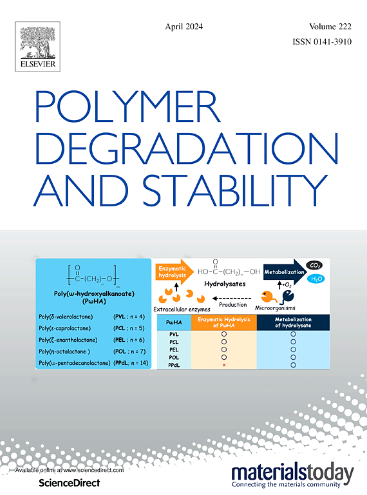A flame retardant coating based on amino acid and phytic acid for cotton fabrics
IF 6.3
2区 化学
Q1 POLYMER SCIENCE
引用次数: 0
Abstract
The effective and eco-friendliness flame retardants for fabrics are increasingly being prioritized. In this study, cotton fabrics were coated with dimethyl phosphite lysine (LP) and phytic acid (PA) to create an eco-friendly and high-efficient fireproof barrier through strong electrostatic attraction and hydrogen bond assembly. The flame-retardant property of the coated cotton fabrics (C/LP10/PA) demonstrated a significant improvement, as evidenced by a limiting oxygen index of 40.2 % and an inherent ability to self-extinguish upon removal of the fire source during vertical burning tests. Furthermore, the synergistic flame-retardant effect of LP and PA resulted in a reduction of 74 % in peak heat release rate and 21 % in total heat release for C/LP10/PA compared to pure cotton. However, the smoke release of C/LP10/PA was increased due to the incomplete combustion. Moreover, the charring process was significantly enhanced in C/LP10/PA with a char residue weight percentage of 26.0 %, from 7.0 % for pure cotton fabric. The analysis of residual char after burning and gaseous products generated during the decomposition process demonstrated that LP/PA coating exhibited flame-retardant properties in both condensed and gas phases. Generally, this work presents a feasible and eco-friendly method for achieving flame retardancy in cotton fabrics.
基于氨基酸和植酸的棉织物阻燃涂层
高效、环保的织物阻燃剂越来越受到重视。本研究在棉织物上涂覆了二甲基亚磷酸酯赖氨酸(LP)和植酸(PA),通过强静电吸引和氢键组装形成了环保高效的防火屏障。在垂直燃烧测试中,涂层棉织物(C/LP10/PA)的阻燃性能得到了显著改善,极限氧指数达到 40.2%,并且在移除火源后具有自熄能力。此外,与纯棉相比,LP 和 PA 的协同阻燃效果使 C/LP10/PA 的峰值热释放率降低了 74%,总热释放率降低了 21%。然而,由于燃烧不完全,C/LP10/PA 的烟雾释放量有所增加。此外,C/LP10/PA 的炭化过程显著增强,残炭重量百分比从纯棉织物的 7.0% 提高到 26.0%。对燃烧后的残炭和分解过程中产生的气态产物的分析表明,LP/PA 涂层在凝结相和气相中都具有阻燃性能。总体而言,这项研究提出了一种实现棉织物阻燃的可行且环保的方法。
本文章由计算机程序翻译,如有差异,请以英文原文为准。
求助全文
约1分钟内获得全文
求助全文
来源期刊

Polymer Degradation and Stability
化学-高分子科学
CiteScore
10.10
自引率
10.20%
发文量
325
审稿时长
23 days
期刊介绍:
Polymer Degradation and Stability deals with the degradation reactions and their control which are a major preoccupation of practitioners of the many and diverse aspects of modern polymer technology.
Deteriorative reactions occur during processing, when polymers are subjected to heat, oxygen and mechanical stress, and during the useful life of the materials when oxygen and sunlight are the most important degradative agencies. In more specialised applications, degradation may be induced by high energy radiation, ozone, atmospheric pollutants, mechanical stress, biological action, hydrolysis and many other influences. The mechanisms of these reactions and stabilisation processes must be understood if the technology and application of polymers are to continue to advance. The reporting of investigations of this kind is therefore a major function of this journal.
However there are also new developments in polymer technology in which degradation processes find positive applications. For example, photodegradable plastics are now available, the recycling of polymeric products will become increasingly important, degradation and combustion studies are involved in the definition of the fire hazards which are associated with polymeric materials and the microelectronics industry is vitally dependent upon polymer degradation in the manufacture of its circuitry. Polymer properties may also be improved by processes like curing and grafting, the chemistry of which can be closely related to that which causes physical deterioration in other circumstances.
 求助内容:
求助内容: 应助结果提醒方式:
应助结果提醒方式:


